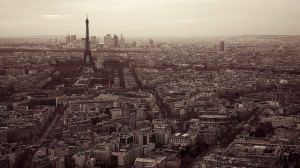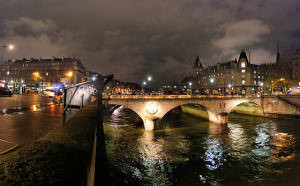History of Paris

When you think of Paris, you probably imagine the Eiffel Tower, sheer luxury, abstract art, upscale fashion, delightful delicacies, or maybe some of the world’s most renowned architecture. These are just a few of the things that attract almost 30 million tourists in a single year, making Paris the world’s top tourist destination region. What most people don’t acknowledge, however, is that the history of Paris dates back over 10,000 years. Starting as a small settlement, it has now become the largest city in France, and one of the most economically powerful regions of Europe. As did much of Europe, Paris has seen its share of turmoil over centuries that contributed to make it the intriguing city it is today.
From Roman conquests in 250 BC, to the Middle Ages with the grand royal palace and birth of the Louvre, the city of Paris has weathered its fair share of disaster and reform. The plague, numerous wars and cultural rebirth of the Renaissance all served as a stepping stone to reinvigorate that has become Paris’ glorious artistic scene today. Paris is an influential city offering a journey through history, culture and fashion. Paris is called home by nearly 19 percent of France’s population and is considered the largest metropolitan city in France, with Marseilles ranking second.
Paris was founded by a tribe known as the Gauls and Romans until Julius Caesar took control and introduced Christianity in the 2nd century AD. Paris continued to develop, change and prosper during the Middle Ages and in the 12th century, construction of the spectacular Notre Dame Cathedral began. Completion of construction took nearly 200 years. The middle Ages introduced other notable monuments such as the Sorbonne, which opened its doors in 1253. Sainte Chapelle was founded in 1248, and construction of the Louvre began in 1200.
After invasions by the Vikings and power struggles between neighboring powers, the rebirth of the Renaissance enabled the revitalization of Paris by the end of the 1400s. Through architecture, Paris carved it’s image into history and permanently cemented its legacy as a city of beauty and lights.
Key highlights of Paris’ history:
- 52 BC – The Roman Empire under Julius Caesar seizes the city, which becomes part of the Roman territory known as Gaul.
- 250 AD – Christianity is introduced and the first churches are constructed throughout the city.
- 4th- 9th Century – Frankish and Norman invasions occur and Clovis I declared the city the kingdom of Gaul and renames Lutetia Paris.
- 1163 AD – Construction of the Notre Dame commences. This monument went on to take nearly two centuries to complete.
- 12th and 13th Century – Monuments and sites are built, including the Sorbonne, Sainte Chapelle Cathedral and the Louvre.
- 14th Century – The plague strikes Paris, killing nearly half of the city’s population.
- 1449 – The historic leader Joan of Arc along with French troops defeat the English, ending a decade of Norman English control over France.
- 15th Century – The rebirth of the Renaissance begins, turning the city into a metropolis of creativity through art, science, and architecture.
- 1643 – Louis XIV becomes king of France in which a period of prosperity and decadence of the wealthy is born. King Louis XIV constructs Versailles in 1623 moving the center of power from Paris to the countryside.
- July 14, 1789 – Bastille Day is known as the day in which Paris is stormed and burned to rubble, making it the beginning of the French Revolution.
- 1792 – Denotes the fall of the monarchy and the creation of the first French republic. The French republic guillotine Louis XVI and Marie Antoinette in 1793 ending the rule of decadence.
- 1799 – Napoleon Bonaparte stabilizes the unruly government and becomes Emperor in 1804. The Emperor’s conquests lead to the colonization of North Africa and was later defeated at Waterloo in 1815.
- Mid-19th Century – Baron Haussmann constructed much of historic Paris that still remains today, under the direction of Napoleon III. Improvements included narrow streets with wide boulevards and a sewer system.
- 1870 – After war with the Prussians, the third Republic is declared, which begins democratic institutions in France. Art nouveau and artistic impressionism burst to life.
- 1920 – 1930 – A plethora of artistic genius make Paris home including Dali, Picasso, Hemingway, James Joyce and many more.
- 1940 – Nazi Germany invades Paris for a four-year occupation.
- 1944 – Paris is liberated by Allied forces and narrowly escapes destruction by the Nazis.
- 1977 – Parisians elected their first Mayor since the French Revolution. Previous leaders were appointed by Napoleon Bonaparte.

While the beauty of Paris can mostly be attributed to the art and architecture of the past, Paris has continued to be on the forefront of change throughout the 21st century. Within the last few generations, many young people have chosen Paris as their new home. This influx of fresh ideas has helped maintain the character, charm and splendour attributed to the city today. As an example, the city’s ongoing socialist movement of 2001 has been responsible for the beautification and social responsibility of Paris. They have introduced “Vélib’,” a program designed to reduce the effects of traffic on the city by renting low-cost bicycles to visitors and residents. Also, in an attempt to maintain the natural beauty of the city, a portion of highway located on the left bank of the Seine has been remodeled into a modern public park designed on five floating gardens.
The elegance and classic beauty of this metropolitan is breathtaking at night with a bounty of monuments that light up and grasp your visual curiosity. Paris is an amazing city that has seen great turmoil and transformation. A visitor can relax in a sidewalk café or visit one of the many historic monuments that survived during periods of unrest and destruction. Urban renewal and new business centers have been added to the city making it a modern twenty first century global city while retaining its allure, mystery and romance from its treacherous past. This makes Paris a number one destination for travelers to explore.

